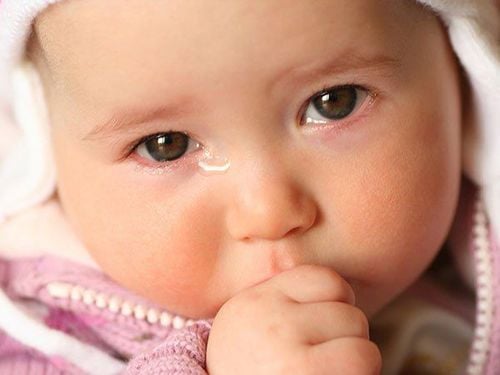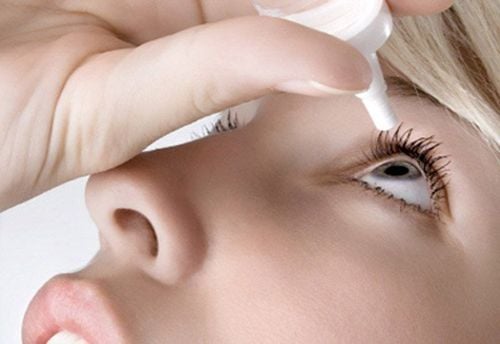This is an automatically translated article.
The article was professionally consulted with Senior Doctor, Specialist II Doan Du Dat - General Internal Medicine - Department of Medical Examination & Internal Medicine - Vinmec Ha Long International Hospital.Emotional processing, empathy, pain relief, and the formation and strengthening of social bonds are all factors that explain the “why cry” problem. However, if you regularly have tears in your eyes for no reason, it could be a sign of a serious condition.
1. What are the types of tears?
The production of tears can be divided into three different purposes. Each has its own use and flows from your tear ducts for a different reason:Basic Tears: These tears coat your eyes all day. Blinking helps spread them over the surface of your eyes. They can improve vision, hydrate your eyes, and sharpen your focus. They protect your eyes and block debris. Your tears also transport oxygen and nutrients to the surface of your eye. To do its job, tears include: Water; mucus to spread tears over the surface of your eyes; Lubricants, which also help prevent your tears from evaporating; Antibodies and special proteins to fight infection. Unpleasant tears: These tears come out from the glands under your eyebrows when you peel an onion, throw it up, or get debris in your eye. They clean your eyes and remove irritants to protect your eyes. Emotional Tears: These tears arise from strong emotions. Empathy, compassion, physical pain, hurt loved ones, moral and emotional feelings can cause tears. They convey your feelings to others. Emotional tears make you feel more vulnerable, which can improve your relationships. Crying often connects people, whether it's because of grief, love, passion, or another strong emotion. Crying can make others empathize and compassionate with you, easing anger or upset emotions. Emotional tears contain more stress hormones and natural pain relievers than other types of tears, and they serve a therapeutic role.

Những giọt nước mắt cảm xúc khiến bạn cảm thấy dễ bị tổn thương hơn
2. Why do we cry?
It is a form of human expression. It has many causes, factors that explain the "why cry". Factors that include:2.1. Cry for help It turns out that "a cry for help" is more than just a saying. Whether your tears come from anger or grief, crying lets others know you're having a hard time.
If you feel unable to directly ask for help, your tears can convey this request without words. Remember that this doesn't mean you're crying on purpose, it's a body response that most people can't easily control.
This idea is supported by a small 2013 study. Participants in this study will look at pictures of sad and neutral faces, with and without tears. They found that people with tears on their faces seemed to have a greater need for support than those who did not.
Research from 2016, also shows that people are generally more agreeable and peaceful than aggressive when they cry. This can help explain your willingness to support someone who is in tears, even if their basic expression doesn't necessarily evoke sadness.
2.2. Cry for pain If you step into an open cupboard door or put your toe on a sharp angle, the sudden intense pain can bring tears to your eyes. However, you're more likely to actually cry when experiencing significant pain over a long period of time, especially if there's not much you can do to ease that pain.
This type of persistent pain can be caused by:
Migraine; Kidney stones ; Broken bones ; An abscessed tooth; Chronic pain condition; Endometrial optimism ; Giving birth... However, the pain is so painful that it makes you cry without any benefit. Research shows that when you cry, your body releases endorphins and oxytocin.
These natural chemicals help ease emotional distress along with physical pain. In other words, crying is a self-soothing behavior of the body.

Có nhiều nguyên nhân, yếu tố giải thích cho việc “tại sao lại khóc”
In fact, revealing your weakness can gain sympathy from others and promote social relationships. Most people need at least some support and companionship from others. These things become even more important in times of vulnerability.
When you allow others to see your weaknesses, they can respond with kindness, compassion, and other forms of emotional support that contribute to meaningful human connection .
2.4. Crying is for emotional processing “Why cry” is for processing emotions. When emotions become so extreme that you don't know how to manage or deal with them, crying can be a way to express them and give you some relief.
Emotional pain can be deeply distressing, so overwhelming feelings of sadness, guilt, or anxiety can certainly make you cry.
But any overwhelming or uncontrollable emotion can make you cry, even if you don't feel particularly painful.
If you've ever shed a tear, you know that even emotions that are usually considered positive, such as love, joy, romantic longing, and gratitude can make you cry.
Experts believe that happy tears can help you regulate intense emotions.
2.5. Crying out of Empathy Crying of sympathy is completely possible. Just as your tears can draw concern and support from others, you can empathize yourself when you see someone else's tears or grief. Witnessing their pain can also make you cry.
Crying in response to someone else's pain is not a bad thing. In fact, it suggests that you can look at other aspects and imagine a situation from someone else's point of view. In short, it means you are an empath.
2.6. Crying is for your needs Some people cry intentionally to attract others, but this behavior doesn't always have bad intentions behind it. Instead, people may "cry" when they don't know a better way to meet their needs.
Emotional support is a legitimate human need, but it's not always easy to do. The helplessness that shows you can't do anything to improve your situation can also lead you to use tears as a tool.
If you feel you can't make a change on your own, you can try to seek sympathy from those who can offer support. However, this may have to be forced, as feelings of frustration and helplessness can make most people cry.
If you are frequently using tears as an alternative to more effective approaches to communication and conflict resolution, a therapist can help you find the underlying reasons behind this behavior and offer solutions. healthier way to express your needs and feelings.
2.7. Crying is also an expression of happiness and joy to the point of falling: "So happy to cry" is the body's response when people are overwhelmed with positive emotions. For example, a wife who has not seen her husband for a long time has disappeared in the battlefield, suddenly meets again, or someone achieves a high achievement beyond their expectations...

“Tại sao lại khóc” là bởi vì để xử lý cảm xúc
3. Why do some people cry more than others?
Some people cry more easily than others. First, women cry 60% more than men. Experts don't know exactly why this gender difference exists.Possibly men:
Have smaller tear ducts; Usually more testosterone, which can inhibit crying; Has less prolactin, a hormone that can promote tears; Often encouraged not to cry. Studies show that people in secure relationships are more comfortable expressing their emotions. They may cry more in normal and healthy environments, while those in insecure relationships may cry even at inappropriate times.
The same study shows that people who avoid close relationships with others cry less and try to avoid tears more. People with clingy or dependent styles cry more often than those in secure relationships.
4. Why do we cry for no reason?
Crying can be normal in certain situations. But if you regularly have tears in your eyes for no reason, it could be a sign of a serious condition.If you notice that you are crying every day during normal activities, you may be suffering from depression. Other symptoms of depression include:
Feeling hopeless, helpless, sad; Loss of interest in life; Loss of appetite or overeating; Poor sleep; Excessive guilt or worthlessness. If you think you have depression, talk to your doctor right away to find the right treatment for you.
Other causes of uncontrollable tears include pathological laughter and crying, which is a condition that can accompany Alzheimer's disease, stroke, or other brain diseases. Talk to your doctor if you suspect you or a loved one has this condition.
5. Why does crying give you a headache?
Sometimes the emotions that make you cry can be so intense that they lead to physical symptoms, such as headaches.Scientists don't fully understand why crying causes headaches, but intense emotions, such as stress and anxiety, seem to activate processes in the brain that pave the way for headaches to occur.
Non-emotional or positive tears don't seem to cause headaches. Researchers have found that crying when you cut onions or when you're happy doesn't cause headaches. Only tears associated with negative emotions have this effect.

Tại sao lại khóc mà không có lý do là suy nghĩ chung của nhiều người
6. What to do when others cry?
If someone starts crying in front of you, your reaction may stem from the discomfort you feel in the situation. Even though you may not mean it, your reaction can make the person crying feel weak or embarrassed.Instead of rushing to cheer or offer immediate help, sometimes it's best to give the person space to cry. Sometimes we need to shed tears to process our emotions.
If you are near someone who is crying:
Acknowledge their sadness, shame or pain and show compassion for their feelings; Please respect their tears. Let them release their feelings and show them you care; Don't rush to give advice or say anything. Give them space to process and reduce tears; After they let you know they're ready to talk, help them navigate their feelings. Be compassionate as you listen to why they are crying and how they feel right now; Don't say much more. Let them think and organize their thoughts; Accept how they respond in the moment. Don't force them to think differently. It's best not to hold back your emotions all the time, but sometimes it's important to hold back your tears. If you need to hold back your crying, try to hold back your tears just until you're in a better place to cry. This way, you won't suppress your emotions completely.
Please dial HOTLINE for more information or register for an appointment HERE. Download MyVinmec app to make appointments faster and to manage your bookings easily.
Reference sources: healthline.com, webmd.com












